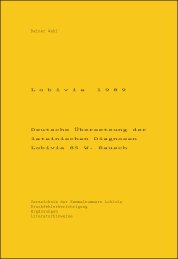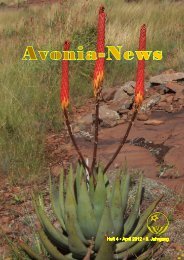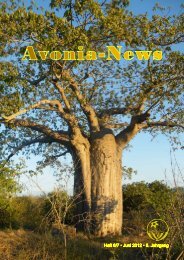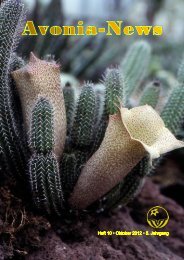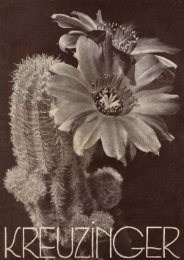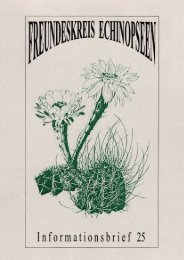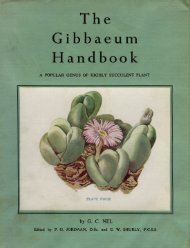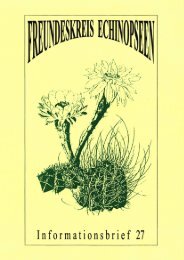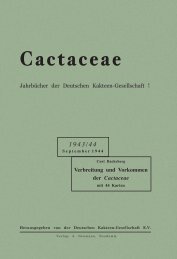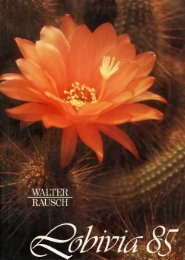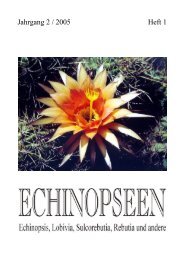Lithops - Au Cactus Francophone
Lithops - Au Cactus Francophone
Lithops - Au Cactus Francophone
Create successful ePaper yourself
Turn your PDF publications into a flip-book with our unique Google optimized e-Paper software.
within 13 miles of the Orange River. A very interesting feature is that those<br />
species with blood red markings are mainly confined to the northern Bank.<br />
L. Dorotheae and L. Inae are the only ones so far as is known, which have<br />
crossed on to the southern side of the Orange River. These two species have,<br />
however, kept fairly close to the river itself and are not found far away from it.<br />
In considering the distribution of L. Lesliei we find that it has ap<br />
parently spread itself along the basin of the Vaal River from Vereeniging<br />
through Klerksdorp and Venterstad as far as Warrenton, while one of its out<br />
posts is found near Bethlehem on a tributary of the Vaal River. This species<br />
also grows near Senekal and at Verkeerde Vlei, O.F.S. The two last named<br />
places are also within the area drained by the Vaal River.<br />
L. pseudotruncatella has a very wide area of distribution and is found<br />
everywhere on the higher plains of the Khomas plateau near Windhoek and<br />
its eastern extensions, and also in the Eros mountains, S.W.A., and their<br />
extensions. This area is more than 5000 square miles. Situated in the middle<br />
of the southern boundary is the Rusch Peak, which is 2420 metres high. On<br />
this peak L. pseudotruncatella also occurs. Dinter described this as an inde<br />
pendent species, L. alpina Dtr., although it is quite obviously a dwarf form<br />
of L. pseudotruncatella. The Khomas and Eros mountain plateaux are broken<br />
up by the Windhoek plain. The latter is about 1600 metres above sea level,<br />
whereas the former are 1800–2000 metres high. In the Windhoek plain no<br />
species of <strong>Lithops</strong> are found. L. pseudotruncatella is here more or less confined<br />
to heights above 1800 metres.<br />
This species also occurs on the south western slopes of the Khomas<br />
plateau as far as Friedenthal in the West, and even reaches the Namib border.<br />
Towards the south it has been found at a height of about 1400 metres. L.<br />
pseudotruncatella also occurs in the eastern extensions of the Khomas plateau.<br />
At Kranzneus on the southern extension of the <strong>Au</strong>as mountains, this species<br />
is frequent at heights of 1750 metres.<br />
Towards the east L. pseudotruncatella has followed the south eastern<br />
extensions of the Khomas plateau, Klein Windhoek. Furthermore, it extends<br />
eastwards from Klein Windhoek to Onde Karemba, Seeis, and from there to<br />
Witvlei up to Heather Bell on the Black and White Nossop, 15 miles east of<br />
Gobabis. Its most northern point in South West Africa is in the Waterberg<br />
Mountains. The total area covered by this species is very great as it is more<br />
or less distributed in all directions from the main centre, the Khomas plateau.<br />
L. pseudotruncatella has not only a very wide horizontal distribution, but it<br />
is one of the few species which has settled at a height of 2420 metres on<br />
the Rusch mountains near Lichtenstein. It is found on the Khomas plateau<br />
at an altitude of approximately 2000 metres, and penetrates as far as Witvlei<br />
near Gobabis. It has been found in the basin of the Nossop, which flows<br />
south wards, and later joins the Orange River. Its most northern outpost is<br />
the Waterberg near Otjiwarongo.<br />
16



